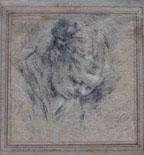Bassano del Grappa, Venice, 1510 - 1592
One of the leading Venetian painters of the 16th century, Jacopo Bassano was the most gifted of a family of artists. After apprenticing in the studio of his father Francesco the Elder, the young Jacopo was sent to Venice in the 1530s to work with Bonifacio Veronese, who greatly influenced him in the style of Venetian masters such as, Giorgione and Titian. Soon Jacopo become responsive to Mannerism, evolving his own personal idiom in both drawing and painting. He worked in Bassano all his life, continuing his father's workshop. As his art matured, his brushstrokes became looser and the forms and masses of his compositions became larger and more lively. During the 1540s his painting was experimental, the anatomy of his characters was forced and their postures unnatural. Over the years his oeuvre became increasingly grand and dramatic, starting with a series of altarpieces whose production dates from the 1550s through to the end of his career. He treated biblical themes in the manner of rustic genre scenes, using genuine country types and portraying animals with real interest. In this way he helped to develop the taste for paintings in which the genre or still-life element assumes greater importance than the ostensible religious subject. Bassano had four painter sons who continued his style, carrying on his studio after his death: Francesco the Younger, Gerolamo, Giovanni Battista, and Leandro.
